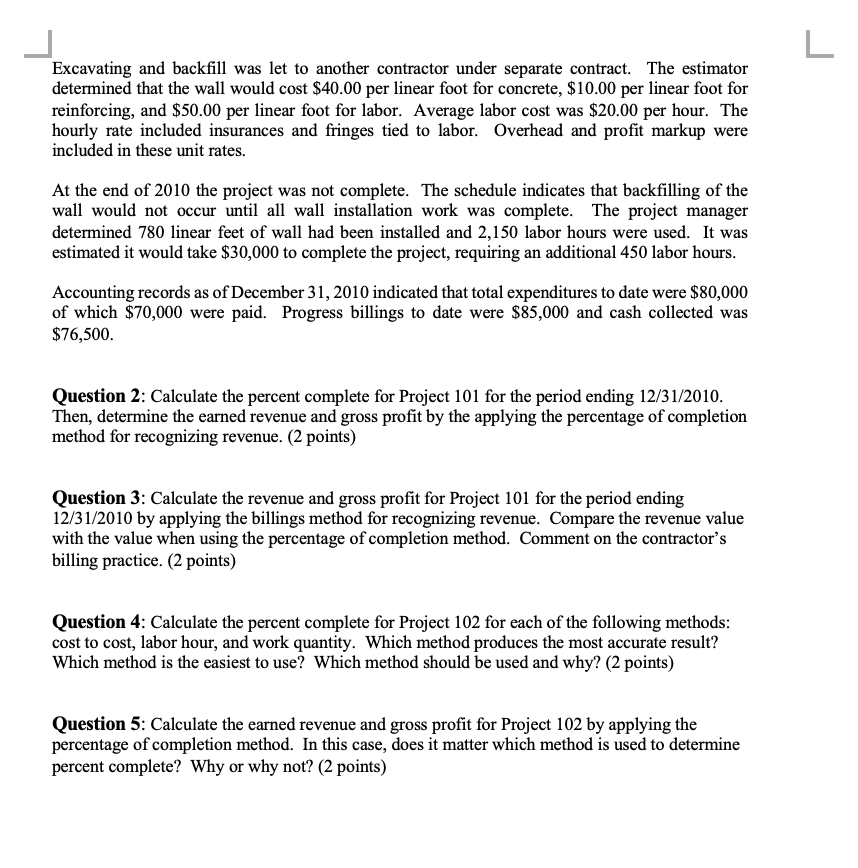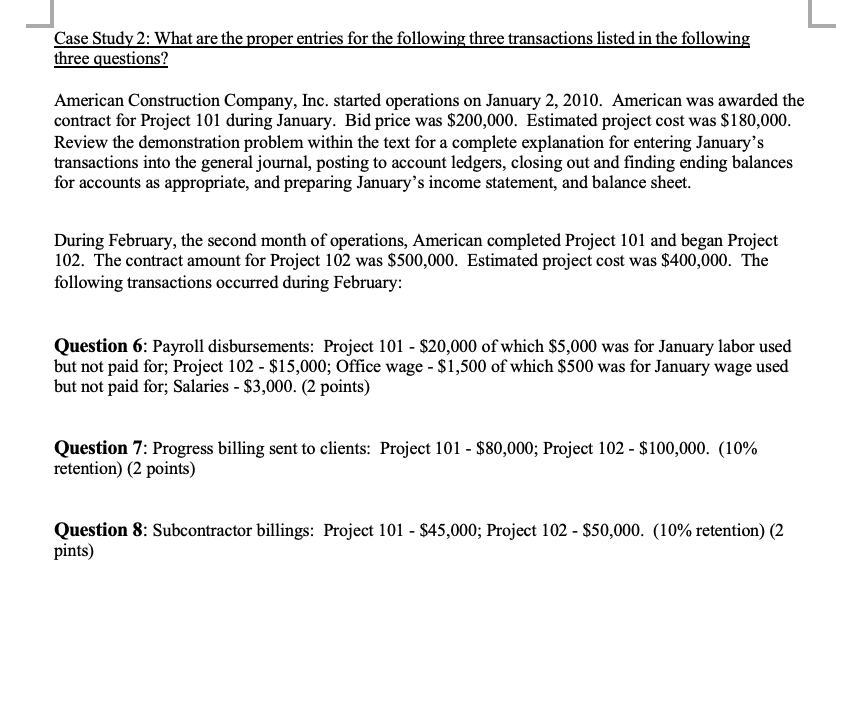


Extra Credit Assignment: Accounting & Company Management Name: PUID Question 1: What is a joint venture and why might two construction firms choose to form one? (2 points) Case Study 1: Please answer the first 4 questions with the following case data for Proiect 101 and Project 102 A construction company began operations on January 2, 2010. During the year the company was awarded three construction contracts. The company incurred $300,000 operating expenses for the year for which $275,000 has been paid while the balance is owed as of December 31,2010. Project data is summarized for each of the three projects in the following paragraphs. Project 101: Low-Rise Office Building The initial contract was signed on January 5, 2010 in the amount of $1,000,000. This amount included $800,000 for construction costs, S150,000 for overhead mark-up, and $50,000 for profit markup. The contractor broke ground on February 4, 2010. During the course of construction the client decided to upgrade the quality of the lighting and plumbing fixtures, resulting in a change order issued to the contractor in the amount of $100,000 on October 7, 2010. The change order price was calculated by the contractor as follows: S50,000 construction costs, $37,500 overhead markup, $12,500 profit markup. At the end of 2010, construction was not complete. However, the client was renting out office space to other entities as well as using some of the offices for the client's own business entity Work remaining as of December 31, 2010 included surfacing the parking lot, erecting a portable parking attendant's station, miscellaneous site concrete work and landscaping. This work was schedule to be completed by May 1, 2010, weather permitting A summary of accounting data as of December 31, 2010 included total construction costs in the amount of $800,000 for which S600,000 was paid. The balance reflected unpaid bills for the month of December, and retention withheld on subcontracts throughout the course of the project. The total progress billing as of December 31, 2010 was $1,000,000 of which $900,000 was collected with the balance outstanding as retention receivable. The project manager estimated that given the work left to be completed, approximately $200,000 of construction cost would be incurred. Project 102: Retaining Wall The initial contract was signed on October 17,2010 in the amount of $100,000. The contract called for 1000 linear feet of 8 foot high retaining wall to be erected in a residential subdivision. Excavating and backfill was let to another contractor under separate contract. The estimator determined that the wall would cost $40.00 per linear foot for concrete, $10.00 per linear foot for reinforcing, and $50.00 per linear foot for labor. Average labor cost was $20.00 per hour. The hourly rate included insurances and fringes tied to labor. Overhead and profit markup were included in these unit rates. At the end of 2010 the project was not complete. The schedule indicates that backfilling of the wall would not occur until all wall installation work was complete. The project manager determined 780 linear feet of wall had been installed and 2,150 labor hours were used. It was estimated it would take $30,000 to complete the project, requiring an additional 450 labor hours Accounting records as of December 31,2010 indicated that total expenditures to date were $80,000 of which $70,000 were paid. Progress billings to date were $85,000 and cash collected was $76,500 Question 2: Calculate the percent complete for Project 101 for the period ending 12/31/2010 Then, determine the earned revenue and gross profit by the applying the percentage of completion method for recognizing revenue. (2 points) Question 3: Calculate the revenue and gross profit for Project 101 for the period ending 12/31/2010 by applying the billings method for recognizing revenue. Compare the revenue value with the value when using the percentage of completion method. Comment on the contractor's billing practice. (2 points) Question 4: Calculate the percent complete for Project 102 for each of the following methods cost to cost, labor hour, and work quantity. Which method produces the most accurate result? Which method is the easiest to use? Which method should be used and why? (2 points) Question 5: Calculate the earned revenue and gross profit for Project 102 by applying the percentage of completion method. In this case, does it matter which method is used to determine percent complete? Why or why not? (2 points) American Construction Company, Inc. started operations on January 2, 2010. American was awarded the contract for Project 101 during January. Bid price was $200,000. Estimated project cost was $180,000. Review the demonstration problem within the text for a complete explanation for entering January's transactions into the general journal, posting to account ledgers, closing out and finding ending balances for accounts as appropriate, and preparing January's income statement, and balance sheet During February, the second month of operations, American completed Project 101 and began Project 102. The contract amount for Project 102 was S500,000. Estimated project cost was $400,000. The following transactions occurred during February Question 6: Payroll disbursements: Project 101 - $20,000 of which S5,000 was for January labor used but not paid for; Project 102 - S15,000; Office wage - S1,500 of which S500 was for January wage used but not paid for, Salaries- $3,000. (2 points) Question 7: Progress billing sent to clients. Project 101-$80,000; Project 102-$100,000. (10% retention) (2 points) Question 8: Subcontractor billings: Project 101-$45,000, Project 102-$50,000. (10% retention) (2 pints) Extra Credit Assignment: Accounting & Company Management Name: PUID Question 1: What is a joint venture and why might two construction firms choose to form one? (2 points) Case Study 1: Please answer the first 4 questions with the following case data for Proiect 101 and Project 102 A construction company began operations on January 2, 2010. During the year the company was awarded three construction contracts. The company incurred $300,000 operating expenses for the year for which $275,000 has been paid while the balance is owed as of December 31,2010. Project data is summarized for each of the three projects in the following paragraphs. Project 101: Low-Rise Office Building The initial contract was signed on January 5, 2010 in the amount of $1,000,000. This amount included $800,000 for construction costs, S150,000 for overhead mark-up, and $50,000 for profit markup. The contractor broke ground on February 4, 2010. During the course of construction the client decided to upgrade the quality of the lighting and plumbing fixtures, resulting in a change order issued to the contractor in the amount of $100,000 on October 7, 2010. The change order price was calculated by the contractor as follows: S50,000 construction costs, $37,500 overhead markup, $12,500 profit markup. At the end of 2010, construction was not complete. However, the client was renting out office space to other entities as well as using some of the offices for the client's own business entity Work remaining as of December 31, 2010 included surfacing the parking lot, erecting a portable parking attendant's station, miscellaneous site concrete work and landscaping. This work was schedule to be completed by May 1, 2010, weather permitting A summary of accounting data as of December 31, 2010 included total construction costs in the amount of $800,000 for which S600,000 was paid. The balance reflected unpaid bills for the month of December, and retention withheld on subcontracts throughout the course of the project. The total progress billing as of December 31, 2010 was $1,000,000 of which $900,000 was collected with the balance outstanding as retention receivable. The project manager estimated that given the work left to be completed, approximately $200,000 of construction cost would be incurred. Project 102: Retaining Wall The initial contract was signed on October 17,2010 in the amount of $100,000. The contract called for 1000 linear feet of 8 foot high retaining wall to be erected in a residential subdivision. Excavating and backfill was let to another contractor under separate contract. The estimator determined that the wall would cost $40.00 per linear foot for concrete, $10.00 per linear foot for reinforcing, and $50.00 per linear foot for labor. Average labor cost was $20.00 per hour. The hourly rate included insurances and fringes tied to labor. Overhead and profit markup were included in these unit rates. At the end of 2010 the project was not complete. The schedule indicates that backfilling of the wall would not occur until all wall installation work was complete. The project manager determined 780 linear feet of wall had been installed and 2,150 labor hours were used. It was estimated it would take $30,000 to complete the project, requiring an additional 450 labor hours Accounting records as of December 31,2010 indicated that total expenditures to date were $80,000 of which $70,000 were paid. Progress billings to date were $85,000 and cash collected was $76,500 Question 2: Calculate the percent complete for Project 101 for the period ending 12/31/2010 Then, determine the earned revenue and gross profit by the applying the percentage of completion method for recognizing revenue. (2 points) Question 3: Calculate the revenue and gross profit for Project 101 for the period ending 12/31/2010 by applying the billings method for recognizing revenue. Compare the revenue value with the value when using the percentage of completion method. Comment on the contractor's billing practice. (2 points) Question 4: Calculate the percent complete for Project 102 for each of the following methods cost to cost, labor hour, and work quantity. Which method produces the most accurate result? Which method is the easiest to use? Which method should be used and why? (2 points) Question 5: Calculate the earned revenue and gross profit for Project 102 by applying the percentage of completion method. In this case, does it matter which method is used to determine percent complete? Why or why not? (2 points) American Construction Company, Inc. started operations on January 2, 2010. American was awarded the contract for Project 101 during January. Bid price was $200,000. Estimated project cost was $180,000. Review the demonstration problem within the text for a complete explanation for entering January's transactions into the general journal, posting to account ledgers, closing out and finding ending balances for accounts as appropriate, and preparing January's income statement, and balance sheet During February, the second month of operations, American completed Project 101 and began Project 102. The contract amount for Project 102 was S500,000. Estimated project cost was $400,000. The following transactions occurred during February Question 6: Payroll disbursements: Project 101 - $20,000 of which S5,000 was for January labor used but not paid for; Project 102 - S15,000; Office wage - S1,500 of which S500 was for January wage used but not paid for, Salaries- $3,000. (2 points) Question 7: Progress billing sent to clients. Project 101-$80,000; Project 102-$100,000. (10% retention) (2 points) Question 8: Subcontractor billings: Project 101-$45,000, Project 102-$50,000. (10% retention) (2 pints)









